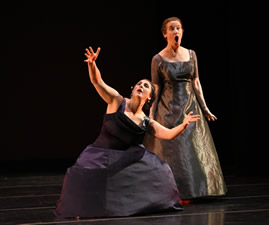Stevens Center was packed for the last of this season’s run of the North Carolina School of the Arts’ beloved annual production of the complete Nutcracker ballet of Peter Ilyich Tchaikovsky (1840-93). This was the 41st staging of the ballet first choreographed in 1966 by the NCSA Dean of the School of the Dance, Robert Lindgren, and his wife Sonja Tyven, a faculty member and founder of the School’s Preparatory Dance Program. They based their adaptation on the original choreography by Lev Ivanov while Duncan Noble, another ballet teacher, choreographed the dance of the Mirlitons. The 1978 sets were replaced in 1998 with an elegant new look. The extensive use of “Carolina Blue” is balm to this old Tarheel. Dark blue and red, not to mention purple/gold, can be so easily overdone.
New music director Robert Moody was in the deep pit, leading his second local Nutcracker. The members of the Winston-Salem Symphony produced a full, warm string sound, with lively woodwinds, and alert brass. Their ensemble was so tight you could not detect any flagging of energy from back-to-back performances. Among the fine solos were those by flutist Kathy Levy, oboist Cara Fish, clarinetist Anthony Taylor, bassoonist Carol Bernstorf, and trumpeter Anita Cirba. The horns, led by Robert Campbell, were at the top of their form.
Drop curtains opened in sequence in Act I to reveal in turn the exterior, an interior hallway, and the party surrounding the Christmas tree. Mimed stage business added realism to the gathering of friends at the party. At the end of the exterior scene, a young girl’s mimed sneeze was timed to match the coda of the music. The antics and squabbles of the young children were well-managed. Their games, and especially their round dances, were nicely matched with the rhythm of the score. One of the youngest boys, dressed in a brown suit with a blue cravat, seemed born for the stage.
It is unusual for the entrance of the characters Grandfather and Grandmother to be greeted by hearty applause. Instead of the listed cast members, founding choreographers Robert Lindgren and Sonja Tyven took these roles to great effect, adding extra electricity to the performance. A washing machine-sized Christmas present disgorged Claire Kretzschmar’s elegant Columbine, Kyle Davis’ agile Harlequin and the angular dance of Billy Morgan’s Toy Soldier.
Nutcracker productions differ in the degree to which the central character Clara dances. Sara DeVinney’s accomplished Clara spent much of her time still or running on the tips of her toes. Her joyous dance, vigorously circling the stage in a series of long horizontal jumps, anticipated the more advanced work of the Sugar Plum Fairy in Act II. She was ably partnered by Josh Sains-Corn who doubled as both Dr. Drosselmeyer’s nephew and the Nutcracker. The magical and mysterious Dr. Drosselmeyer was portrayed by Marin Boieru, currently ballet master of Raleigh’s Carolina Ballet. As Mouse King, Billy Morgan led a lively crew prone to shaking their booty for comic effect. These more advanced dancers, including the Nutcracker’s soldiers and the snow flakes, carried out their interleaving lines and geometric forms with confidence. The solos of Amy Saunder’s Snow Queen and Adam Chavis’s Snow King were very well done.
A major reason for selecting the last performances was the presence of two NCSA alumni guest dancers in Act II. Lilyan Vigo Ellis graduated from the NCSA in 1996 and is a founding member of the Carolina Ballet where she has created many principal parts in new works. She proved to be a superb Sugar Plum Fairy with every movement balanced and elegant and seeming to soar weightlessly. Her noble Cavalier was Jonathan Stiles. He is a high school and B.F.A. graduate of the NCSA and is currently a member of the Pennsylvania Ballet. Their pas de deux was breathtaking and riveting. Their solos were of the same high standard. The student dancers performed the sequence of national dances with poise and élan. The spirit of flamenco haunted the Spanish Dance or chocolate, ably supported by Anita Cirba’s agile trumpet. Slow, flowing music underpinned the sensuous, undulating gyrations of the Arabian or Coffee Dance. I have always found the choreography for the Chinese or Tea Dance inscrutable with its fast, mincing gait and pointed fingers. The vigorous Russian Trepak Dance never fails to please the crowd. The title of the Mirlitons Dance may be a multiple pun, possibly referring to the flute duet in the music or the marzipan that the dance represents and the almonds used in Mirliton pastries. Kyle Davis’s lead role in this dance was most impressive. Edwin Martinat as Mother Ginger played up the drag queen possibilities of the role, egged on by an enthusiastic claque.
The high standard of all the student performances, the surprise appearance of Lindgen and Tyven (on his birthday), and the excellence of the Guest Sugar Plum Fairy and her Cavalier made this a Nutcracker to remember and wax nostalgic about over hot cocoa.











